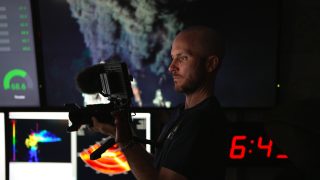The scenes documented on video during the Octopus Odyssey expedition are stunning and informative. Of course, octopus were the “stars of the show:” we documented octopus nurseries with hundreds of Muusoctopus species brooding viable eggs in low-temperature hydrothermal fluids, saw how octopus mothers protect and clean their eggs, as well as observed predators rapidly descending on unprotected eggs.
The research team explored five new seamounts that had never been visited before, several of which were mapped at high resolution for the first time on this expedition. On many of these seamounts, the team studied unexpected geological features, where millions-of-years-old layers of sediment are exposed at the seafloor, interspersed with the basaltic rock formations.
Some of the outcrops and seamounts are separated by just a few kilometers, but the team observed very different assemblages of creatures on them. This indicates the high diversity and uniqueness of each area. More studies are needed to evaluate how specialized the organisms in this small portion of the ocean floor are, compared to other deep areas in the region (and farther away). This chapter of the #OctoOdyssey has ended, but we will be back in December for the next!

